 |
 |
 |
| |
The HIV Integrase Inhibitor Elvitegravir (EVG/r)
Has Potent and Durable Antiretroviral Activity in Treatment-Experienced Patients with Active Optimized Background Therapy (OBT)
|
| |
| |
Reported by jules Levin
ICAAC, Sept 17-20, 2007, Chicago
Andrew Zolopa reported these study results.
AR Zolopa1, H Lampiris2, G Blick3, C Walworth4, L Zhong5, SL Chuck5,
J Enejosa5, BP Kearney5, and AK Cheng5
1Stanford University, Stanford, CA; 2UCSF/San Francisco VAMC, San Francisco, CA; 3Circle Medical, Norwalk, CT; 4CSI Clinical Trials, Fountain Valley, CA;
5Gilead Sciences, Inc., Foster City, CA, USA
AUTHOR CONCLUSIONS
--Decline in HIV RNA with EVG/r 125 mg is rapid, however, active OBT is critical to maintain virologic response
--Magnitude and durability of virologic response are enhanced when EVG/r 125 mg is combined with another potent agent (T-20)
--Boosted PIs add durable, potent efficacy to EVG/r 125 mg
--Plan further evaluation of EVG/r + boosted PIs and other potent agents
BACKGROUND
--Dihydroquinoline carboxylic acid strand transfer inhibitor of HIV integrase
--Serum-free IC50 = 0.2 nM; EC90 = 1.2 nM in PBMCs
--Active against NRTI-, NNRTI-, and PI-resistant isolates tested
--No dose-limiting chronic animal toxicity
Phase 2 Study design
Zolopa said this study has a complicated design and requires a few moments to consider. Essentially this study used a different OBT than the raltegravir study in treatment-experienced. In this study the OBT consisted of NRTIs =/- T-20, but PI use was initially prohibited due to lack of drig-drug interaction data, and tipranavir and darunavir were permitted to be added after week 8. In the raltegravir study these PIs were permited at study onset.
--Randomized, active-controlled, partially-blinded (dose of EVG), dose-finding study
--Non-inferiority study of EVG (boosted with ritonavir) and comparator PIs (CPI/r)
--Optimized Background Therapy (OBT) consisted of NRTIs +/- T-20 at investigator's discretion
--PI use in EVG/r arms initially prohibited due to lack of drug-drug interaction data; DSMB permitted adding DRV or TPV after Week 8
--Two EVG/r 125 mg subjects added PI prior to Week 16 (both Week 15)
Primary endpoint was time-weighted average change from baseline in HIV RNA through 24 weeks (DAVG24)
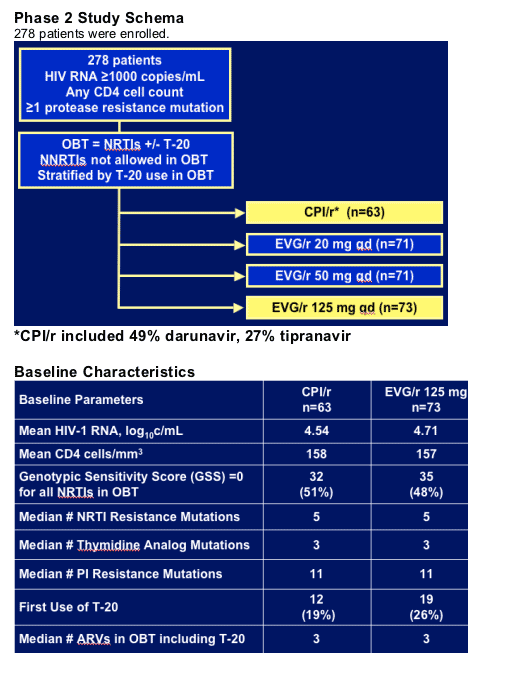
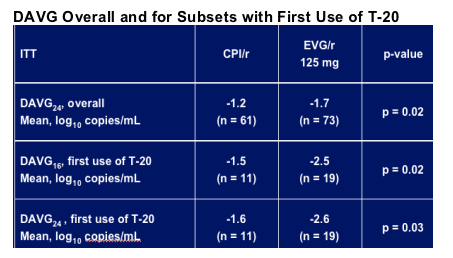
The data in the table above was presented at CROI, Zolopa said for this presentation he wanted to focus on the impact of having other active drugs in the background regimen as demonstrated in the table above by the addition of T20 for patients who had not used T20 before.
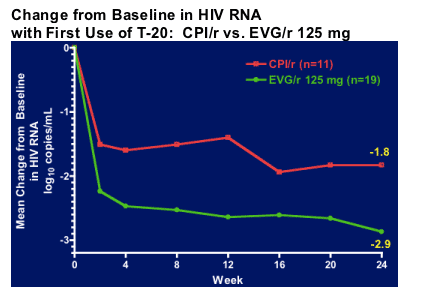
(Data from patients after changing regimen were excluded)
--11 CPI/r subjects received the following PIs: 6 DRV/r, 1 TPV/r, 4 other PI/r
--Mean baseline HIV RNA for the CPI/r pts with new T-20=4.71 log; for the EVG/r 125 mg pts with new T-20=4.98 log
HIV RNA < 50 copies/mL at Week 16
for Patients with First Use of T-20
25% receiving CPI/r arm achieved <50 c/ml and 74% receiving EVG/r with First Use T20 achieved <50 c/ml.
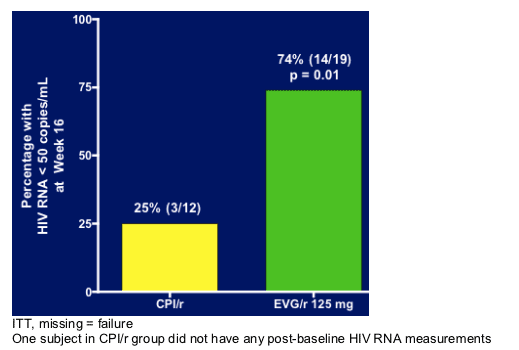
Zolopa said, these data compare favorably with the raltegravir Phase 3 subset data. At the FDA Advisory Committee meeting on raltegravir, the FDA presented an analysis from the Phase 3 studies showing 72% (33/46) of subjects given raltegravir with naive use of T-20 and not naive use of darunavir (although these subjects could have reused darunavir or had another boosted PI) had HIV RNA < 50 copies/mL at Week 16 compared to 52% (13/25) of subjects given placebo with naive use of T20 (p=NS by Fisher's Exact test). In this study of EVG/r, subjects given EVG/r 125 mg who did not start with a boosted PI in OBT had a comparable proportion (74%) of HIV RNA < 50 copies/mL and the rate in the comparator PI group was much lower (25%; p=0.01).
Change in HIV RNA With EVG/r 125 mg:
Influence of Gradations in Activity of OBT
Patients receiving no active OBT had -0.7 log reduction when using EVG/r. For these patients you can see in the graph there was a rapid decline in viral load but there was a rebound towards baseline after 2 weeks for these patients who ended up with a -0.7 viral load decline. Patients with 1 or more active NRTIs without first use of T20 had a -1.7 log viral load reduction, and Zolopa added we know that even though resistance testing may say a drug is active there may be limited activity due to prior use of a drug in that class. But for patients who used T20 for the first time along with EVG/r the viral load decline was rapid by week 2 with about a -2.2 log decline and continued to decline achieving a -2.9 log decline at week 24. Zolopa said, data with T-20 is an example of the efficacy of EVG/r 125 mg with another potent, fully-active agent.
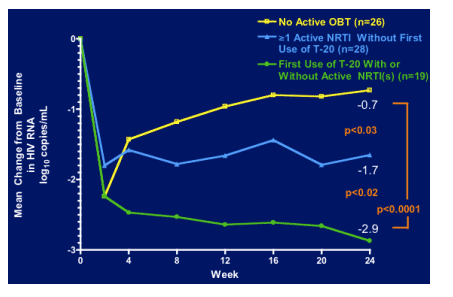
Data from EVG/r 125 mg patients after addition of a PI were excluded
Week 16 HIV RNA < 50 copies/mL for Patients Receiving
EVG/r 125 mg: Impact of Gradations in Activity of OBT
The importance of added active drugs to the use of EVG/r is further demonstrated here, Zolopa said. 15% of patients with no active OBT achieved <50 c/ml at week 16. While 30% patients with 1 active NRTI achieved <50 c/ml, and 44% achieved <50 c/ml when they had 2 or more active NRTIs. And 74% achieved <50 c/ml with first use Fuzeon +/- active NRTIs.
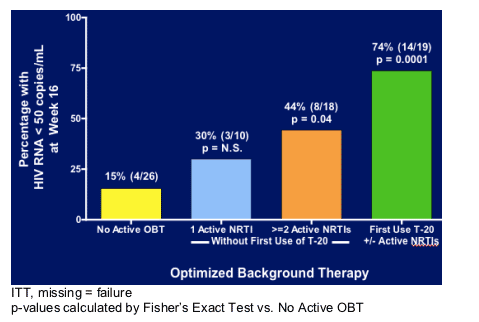
Virologic Suppression After Addition of Protease Inhibitors to OBT of EVG/r 125 mg Subjects
Zolopa mentioned the Benchmark studies did allow use of protease inhibitors as background therapy but in this study they were not allowed initially, but the DSMB did allow the addition of PIs after the study started and some patients added protease inhibitors. The graph shows the impact of adding PIs. At baseline about 20% of patients had undetectable viral load so the need to add a PI was variable depending on the individual patient's situation. By week 24, for patients adding a PI 69% achieved <400 c/ml and 62% <50 c/ml.
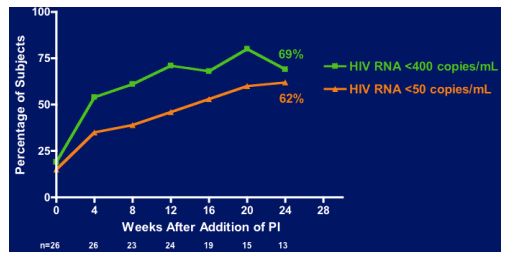
--Mean HIV RNA = 3.9 log10 copies/mL prior to adding PI
--Mean change in HIV RNA after PI = -1.0 log10 copies/mL ( median follow-up 24 weeks)
|
| |
|
 |
 |
|
|